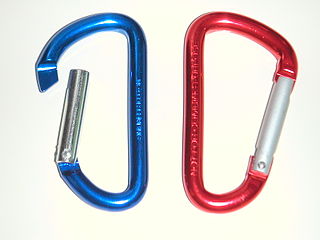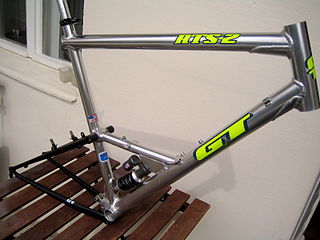Related Research Articles
Aluminium–silicon alloys or Silumin is a general name for a group of lightweight, high-strength aluminium alloys based on an aluminum–silicon system, i.e., Aluminium-silicon alloys (AlSi) that consist predominantly of aluminum - with silicon as the quantitatively most important alloying element. Pure AlSi alloys cannot be hardened, the commonly used alloys AlSiCu and AlSiMg can be hardened. The hardening mechanism corresponds to that of AlCu and AlMgSi. The rarely used wrought alloys in the 4000 series and the predominantly used cast alloys are standardizedin the 40000 series. AlSi alloys are by far the most important of all aluminum cast materials. They are suitable for all casting processes and have excellent casting properties. Important areas of application are in car parts, including engine blocks and pistons. In addition, their use as a functional material for high-energy heat storage in electric vehicles is currently being focused on.

Anodizing is an electrolytic passivation process used to increase the thickness of the natural oxide layer on the surface of metal parts.
Titanium alloys are alloys that contain a mixture of titanium and other chemical elements. Such alloys have very high tensile strength and toughness. They are light in weight, have extraordinary corrosion resistance and the ability to withstand extreme temperatures. However, the high cost of both raw materials and processing limit their use to military applications, aircraft, spacecraft, bicycles, medical devices, jewelry, highly stressed components such as connecting rods on expensive sports cars and some premium sports equipment and consumer electronics.

An aluminium alloy is an alloy in which aluminium (Al) is the predominant metal. The typical alloying elements are copper, magnesium, manganese, silicon, tin, nickel and zinc. There are two principal classifications, namely casting alloys and wrought alloys, both of which are further subdivided into the categories heat-treatable and non-heat-treatable. About 85% of aluminium is used for wrought products, for example rolled plate, foils and extrusions. Cast aluminium alloys yield cost-effective products due to the low melting point, although they generally have lower tensile strengths than wrought alloys. The most important cast aluminium alloy system is Al–Si, where the high levels of silicon (4–13%) contribute to give good casting characteristics. Aluminium alloys are widely used in engineering structures and components where light weight or corrosion resistance is required.
7075 aluminium alloy (AA7075) is an aluminium alloy with zinc as the primary alloying element. It has excellent mechanical properties and exhibits good ductility, high strength, toughness, and good resistance to fatigue. It is more susceptible to embrittlement than many other aluminium alloys because of microsegregation, but has significantly better corrosion resistance than the alloys from the 2000 series. It is one of the most commonly used aluminium alloys for highly stressed structural applications and has been extensively used in aircraft structural parts.
2024 aluminium alloy is an aluminium alloy, with copper as the primary alloying element. It is used in applications requiring high strength to weight ratio, as well as good fatigue resistance. It is weldable only through friction welding, and has average machinability. Due to poor corrosion resistance, it is often clad with aluminium or Al-1Zn for protection, although this may reduce the fatigue strength. In older systems of terminology, 2XXX series alloys were known as duralumin, and this alloy was named 24ST.
5086 is an aluminium alloy, primarily alloyed with magnesium. It is not strengthened by heat treatment, instead becoming stronger due to strain hardening, or cold mechanical working of the material.

Alclad is a corrosion-resistant aluminium sheet formed from high-purity aluminium surface layers metallurgically bonded to high-strength aluminium alloy core material. It has a melting point of about 500 °C (932 °F). Alclad is a trademark of Alcoa but the term is also used generically.
5083 aluminium alloy is an aluminium alloy with magnesium and traces of manganese and chromium. It is highly resistant to attack by seawater and industrial chemicals.
2014 aluminium alloy (aluminum) is an aluminium-based alloy often used in the aerospace industry.
5005 aluminium alloy is an aluminium alloy with good resistance to atmospheric corrosion. It is used in decorative and architectural applications.
1050 aluminium alloy is an aluminium-based alloy in the "commercially pure" wrought family. As a wrought alloy, it is not used in castings. Instead, it is usually formed by extrusion or rolling. It is commonly used in the electrical and chemical industries, on account of having high electrical conductivity, corrosion resistance, and workability. 1050 alloy is also sometimes used for the manufacture of heat sinks, since it has a higher thermal conductivity than other alloys. It has low mechanical strength compared to more significantly alloyed metals. It can be strengthened by cold working, but not by heat treatment.
1100 aluminium alloy is an aluminium-based alloy in the "commercially pure" wrought family. With a minimum of 99.0% aluminium, it is the most heavily alloyed of the 1000 series. It is also the mechanically strongest alloy in the series, and is the only 1000-series alloy commonly used in rivets. At the same time, it keeps the benefits of being relatively lightly alloyed, such as high electrical conductivity, thermal conductivity, corrosion resistance, and workability. It can be hardened by cold working, but not by heat treatment.
2219 aluminium alloy is an alloy in the wrought aluminium-copper family. It can be heat-treated to produce tempers with higher strength but lower ductility. The aluminium-copper alloys have high strength, but are generally less corrosion resistant and harder to weld than other types of aluminium alloys. To compensate for the lower corrosion resistance, 2219 aluminium can be clad in a commercially pure alloy such as 1050 or painted. This alloy is commonly formed by both extrusion and forging, but is not used in casting.
3003 aluminium alloy is an alloy in the wrought aluminium-manganese family. It can be cold worked to produce tempers with a higher strength but a lower ductility. Like most other aluminium-manganese alloys, 3003 is a general-purpose alloy with moderate strength, good workability, and good corrosion resistance. It is commonly rolled and extruded, but typically not forged. As a wrought alloy, it is not used in casting. It is also commonly used in sheet metal applications such as gutters, downspouts, roofing, and siding.
3102 aluminium alloy is an alloy in the wrought aluminium-manganese family. It is one of the most lightly alloyed grades in the 3000 series, with at least 97.85% aluminium by weight. Like most other aluminium-manganese alloys, 3102 is a general-purpose alloy with moderate strength, good workability, and good corrosion resistance. Being lightly alloyed, it tends on the lower strength and higher corrosion resistance side. It can be cold worked to produce tempers with a higher strength but a lower ductility. It can be formed by rolling, extrusion, and forging. As a wrought alloy, it is not used in casting.
5456 aluminium alloy is an alloy in the wrought aluminium-magnesium family. While it is closely related to 5356 aluminium alloy, it is used in structural applications, like most other aluminium-magnesium alloys, and not as filler for welding. As a wrought alloy, it can be formed by rolling, extrusion, and forging, but not casting. It can be cold worked to produce tempers with a higher strength but a lower ductility. It is susceptible to exfoliation corrosion when held at temperatures above 65 °C (150 °F) for extended periods of time.
2195 aluminium alloy is an alloy in the wrought aluminium-copper family. It is one of the Weldalite family of Aluminium–lithium alloys. It is one of the most complex grades in the 2000 series, with at least 91.9% aluminium by weight. 2195 aluminium can be alternately referred to by the UNS designation A92195.
2218 aluminium alloy is an alloy in the wrought aluminium-copper family. It is one of the most complex grades in the 2000 series, with at least 88.4% aluminium by weight. Unlike most other aluminium-copper alloys, 2218 is a high work-ability alloy, with relatively low for 2xxx series alloy yield strength of 255 MPa. Despite being highly alloyed, it have a good corrosion and oxidation resistance due sacrificial anode formed by magnesium inclusions, similar to marine-grade 5xxx series alloys. Although 2218 is wrought alloy, owing to granular structure it can be used in casting and been precisely machined after casting. It is easy to weld, coat, or glue.
Aluminium brass is a technically rather uncommon term for high-strength and partly seawater-resistant copper-zinc cast and wrought alloys with 55-66% copper, up to 7% aluminium, up to 4.5% iron, and 5% manganese. Aluminium bronze is technically correct as bronze, a zinc-free copper-tin casting alloy with aluminium content.